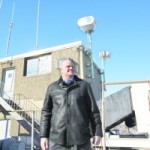New laser network between NYSE and NASDAQ will allow high …

Share This article
High-frequency trading — the practice of making thousands of algorithmic stock trades per minute — is about to get a big boost in the USA. Anova, a company that specializes in deploying low-latency networks for stock trading, is completing an ultra-high-speed laser network between the New York Stock Exchange (NYSE) and the NASDAQ. The link will be just a few nanoseconds faster than the current microwave and fiber-optic links — but in the world of high-frequency trading (HFT), those nanoseconds could result in millions of dollars in profits for the trading companies. Such is the insanity of the stock markets; such is the unbelievable capacity of HFT to create money out of almost nothing.
If you want to get a signal quickly from point A to point B, you basically have three options: fiber-optic cables, a network of microwave dishes, or laser links. Electrical (copper wire) networks are feasible over short runs, but their reduced functionality and bandwidth over longer runs makes them less desirable than fiber. Microwave (and even higher-frequency millimeter wave) networks also aren’t very high-bandwidth, but because they’re purpose-built, they can take a very direct route, significantly undercutting the latency of an oft-congested and round-about fiber network. Laser networks have all the advantages of microwave/millimeter wave networks, but they have higher bandwidth, and some very clever adaptive optics means they’re not impacted by bad weather. (Microwaves really hate inclement weather.)
Last year, Anova completed a laser network link between the London and Frankfurt stock exchanges, and now, it seems the company is nearing completion on a similar laser network between the NYSE and NASDAQ data centers in Mahwah and Carteret, New Jersey. In the case of both networks, Anova is using equipment provided by AOptix, an American company that is contracted by the US military to produce similar laser-based systems for ground-to-aircraft communications. Each AOptix base station is capable of “carrier-grade” availability (five nines, 99.999%) over a distance of 10 kilometers (6.2 miles). The route, which is about 35 miles as the crow flies and skirts the center of Newark, will probably feature around six or seven base stations, each of which will have a direct line of sight with its two nearest neighbors. The link speed, according to the AOptix tech specs, will be around 2Gbps — not exactly massive by fiber-optic standards, but more than enough for a few thousand trades per second.
The cost of building the network won’t have been cheap — probably a few million dollars — but that’s absolutely pennies for stock traders. (The new fiber link between London and Tokyo, which is also primarily for stock traders, will cost $1.5 billion.)
Anova’s CEO, Michael Persico, with an AOptix laser network link above his head [Image credit: WSJ]
The exact latency improvement of the NYSE-NASDAQ laser network isn’t yet known, but over a distance of just 35 miles we’re probably talking about nanoseconds. A microwave system currently in place between Chicago and NYC — a straight-line distance of around 800 miles — has a latency of 4.13 milliseconds. Scaling that down to 35 miles (dividing it by 23), you get a latency of 0.18 milliseconds between the NYSE and NASDAQ. I don’t know how fast the existing fiber/microwave links are, but even a difference of a few nanoseconds would be enough to beat out other high-frequency trading companies that are using older, slower networks. Anova, unsurprisingly, says it has dozens of trading firms who want to use the new laser network, all of which could stand to boost their profits. Though, as with all HFT technology, once everyone is using it (or something comparable) profit levels will revert.
And thus the craziness that is high-speed trading continues unabated, faster and more profitable than ever before.
Tagged In
Share This Article
Excerpt from:
New laser network between NYSE and NASDAQ will allow high …


